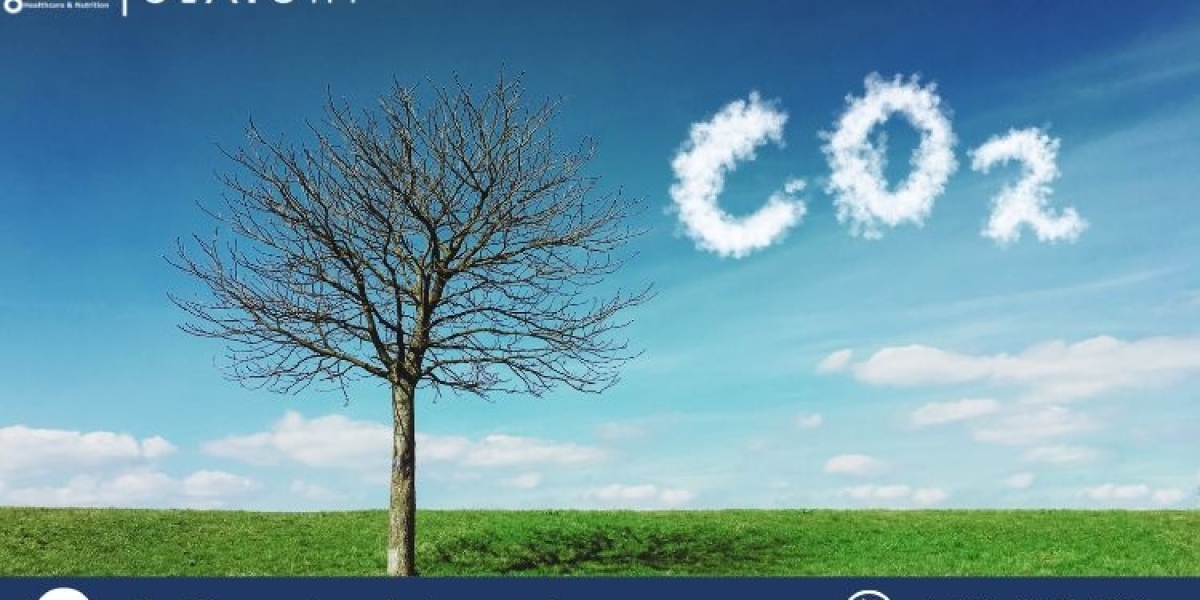The United Kingdom Carbon Dioxide Market is a key player in a variety of industrial sectors, ranging from food and beverage to chemicals and oil and gas. As of 2024, the UK carbon dioxide market has reached a volume of 725.80 KMT (Kilo Metric Tonnes). The market is forecasted to grow at a compound annual growth rate (CAGR) of 1.50% from 2025 to 2034, with the volume projected to reach 842.32 KMT by the end of the forecast period. This article provides a detailed analysis of the United Kingdom carbon dioxide market, covering its size, share, dynamics, trends, growth prospects, opportunities, challenges, and competitive landscape.
Overview of the United Kingdom Carbon Dioxide Market
The carbon dioxide market in the United Kingdom plays an essential role in several industries, particularly in the food and beverage sector, chemical manufacturing, agriculture, and oil and gas. CO2 is utilized in various applications, such as carbonation of beverages, preservation of food, chemical production, and oil recovery processes.
As an industrial gas, carbon dioxide’s versatility has led to increased demand in numerous fields, each requiring CO2 for specific purposes. The UK government’s policies aimed at reducing carbon emissions, coupled with the growing demand for sustainable CO2 production methods, have added a new dimension to the market. The market's performance is significantly impacted by factors such as technological advancements in CO2 capture and storage (CCS), the drive for sustainability, and regulatory frameworks governing industrial emissions.
Size and Share of the United Kingdom Carbon Dioxide Market
The carbon dioxide market in the United Kingdom was valued at 725.80 KMT in 2024, reflecting the growing demand for CO2 across multiple industries. The market’s size and share are determined by the consumption patterns of major industrial sectors, each having its own unique CO2 requirements.
Food and Beverage Sector: The food and beverage industry is one of the largest consumers of carbon dioxide in the UK. CO2 is used in various applications such as carbonation in sodas, beer, and sparkling waters, as well as in food preservation through modified atmosphere packaging (MAP). This sector is expected to maintain a significant market share in the coming years due to the ongoing consumer preference for carbonated beverages and convenience foods.
Chemical and Pharmaceutical Industries: In addition to the food and beverage sector, CO2 is widely used in chemical production, particularly in the synthesis of chemicals like urea, methanol, and other products used in fertilizers and pharmaceuticals. The pharmaceutical industry also uses CO2 in medical applications, particularly in cryogenics and the production of sterile products.
Oil and Gas Industry: The oil and gas sector, particularly in the North Sea, uses carbon dioxide for enhanced oil recovery (EOR) processes. By injecting CO2 into oil reservoirs, operators can increase the rate of oil recovery from mature oil fields. This has contributed to the growing share of the CO2 market, especially as the demand for EOR technologies continues to rise.
Agricultural Sector: The agricultural sector also relies on CO2 for various applications, such as enhancing photosynthesis in greenhouse farming. The use of CO2 in agriculture helps increase crop yields and is gaining traction as sustainable farming practices become more popular.
The overall share of the market is currently dominated by major players in the industrial gases sector, including companies that cater to both large-scale industrial operations and smaller-scale applications across multiple industries.
Market Dynamics and Trends of the United Kingdom Carbon Dioxide Market
Several factors are influencing the carbon dioxide market in the UK, driving both demand and innovation across industries. These dynamics range from regulatory pressures to advancements in CO2 utilization and sustainability.
Regulatory Push for Carbon Reduction: The UK government has set ambitious targets for achieving net-zero carbon emissions by 2050. As part of its climate action plan, the government has implemented stringent regulations aimed at reducing CO2 emissions across various sectors. This has led to the increased adoption of carbon capture and storage (CCS) technologies, which involve capturing CO2 emissions from industrial processes and storing them underground. This shift towards carbon reduction has boosted demand for CO2 as it plays a role in emissions management.
Technological Advancements in CO2 Utilization: Technological advancements are rapidly expanding the applications of CO2. For example, CO2 is now being utilized in the production of synthetic fuels, biofuels, and chemicals, which have a reduced environmental impact compared to traditional fuels. This is creating new market opportunities for CO2, particularly in the energy and chemical sectors.
Increasing Adoption of CO2 in Agriculture: The use of CO2 in agriculture has gained popularity as a means to increase crop yields. Greenhouse farming techniques that use CO2 to enhance photosynthesis are helping boost productivity and reduce water consumption. This trend is expected to drive further demand for CO2 in the agriculture sector, especially as the global population continues to grow, putting pressure on food production systems.
Growing Focus on Sustainability: There is an increasing emphasis on sustainable CO2 production methods, such as capturing CO2 from renewable sources like biomass. Green CO2, produced using renewable energy, helps reduce the environmental impact of traditional CO2 production. This trend is expected to play a significant role in shaping the future of the CO2 market, as businesses and industries seek more environmentally friendly alternatives.
Shift Towards Carbon Capture and Storage (CCS): CCS is emerging as a key technology for mitigating CO2 emissions, especially in energy-intensive industries. Several projects are underway in the UK, supported by government policies that incentivize CO2 capture, transport, and storage. The expansion of CCS technologies will contribute to the growing demand for CO2 and enhance its role in the UK's carbon management strategy.
Get a Free Sample Report with a Table of Contents:
https://www.expertmarketresearch.com/reports/united-kingdom-carbon-dioxide-market/requestsample
Growth of the United Kingdom Carbon Dioxide Market
The growth of the carbon dioxide market in the United Kingdom is expected to be steady, with a forecasted CAGR of 1.50% from 2025 to 2034. The growth is driven by several key factors:
Increased Demand from Food and Beverage Industry: The food and beverage industry will continue to be a significant driver of CO2 demand in the UK. The rise in consumer demand for carbonated drinks, packaged foods, and convenience items ensures that CO2 will remain in high demand for carbonation, food preservation, and packaging.
Advancements in CO2 Recycling: Technological developments in CO2 recycling are presenting new opportunities for the market. CO2 captured from industrial processes can be purified and reused for various applications, reducing waste and improving environmental sustainability. This trend is expected to contribute to the overall growth of the market by promoting a circular economy.
Enhanced Oil Recovery (EOR) Initiatives: Enhanced oil recovery (EOR) methods, which involve injecting CO2 into oil reservoirs to increase production, will continue to drive CO2 demand in the UK’s oil and gas sector. As the demand for EOR increases, so too will the need for CO2, supporting growth in the market.
Rising Agricultural and Greenhouse Applications: The adoption of CO2 enrichment in agriculture is set to rise, particularly in greenhouse farming. CO2 plays a crucial role in enhancing plant growth and productivity, making it an essential component of modern agricultural practices. This trend will contribute to market growth over the forecast period.
Market Opportunities and Challenges in the United Kingdom Carbon Dioxide Market
The United Kingdom carbon dioxide market offers several opportunities and faces several challenges that could shape its growth prospects.
Opportunities:
CO2 Recycling and Reuse Technologies: The growing focus on sustainability and the circular economy presents opportunities for the CO2 market. Advances in CO2 recycling and reuse technologies are enabling businesses to capture and repurpose CO2 emissions for other industrial applications, reducing environmental impacts and driving market growth.
Expansion of Carbon Capture and Storage (CCS): The UK’s commitment to reducing carbon emissions and achieving net-zero targets by 2050 presents a significant opportunity for CO2 suppliers. The expansion of CCS technologies is expected to increase the demand for CO2 as a key component in emissions mitigation efforts.
Agricultural and Industrial Applications: The use of CO2 in agriculture, particularly in greenhouse farming, presents a growing market opportunity. Additionally, the increasing adoption of CO2 in industrial processes such as metal manufacturing, water treatment, and refrigeration will support market growth.
Challenges:
High Production Costs: The production of CO2, particularly green CO2 from renewable sources, can be expensive. These high production costs may limit the widespread adoption of CO2 solutions, particularly for smaller businesses with limited budgets.
Environmental Concerns over CO2 Storage: The long-term safety and environmental impact of storing CO2 underground are subjects of debate. As more CO2 is captured and stored as part of CCS initiatives, concerns regarding potential leaks and environmental risks may pose a challenge to the growth of this technology.
Regulatory and Compliance Costs: As the regulatory landscape around carbon emissions becomes more stringent, businesses may face increased compliance costs. Meeting emissions reduction targets will require substantial investment in CO2 capture and storage technologies, which could put pressure on market participants.
Competitor Analysis in the United Kingdom Carbon Dioxide Market
The carbon dioxide market in the United Kingdom is highly competitive, with several large and well-established players. These companies are crucial in supplying CO2 to key industries across the UK.
BOC Limited (Linde): BOC Limited, a part of Linde Group, is one of the leading players in the UK CO2 market. It provides CO2 for a range of industrial applications, including food and beverage carbonation, pharmaceuticals, and oil and gas. With its extensive distribution network and focus on sustainability, BOC is a key player in the market.
Air Liquide UK Ltd: Air Liquide is a global leader in industrial gases and has a significant presence in the UK market. It supplies CO2 to various industries, including food processing, healthcare, and chemicals. Air Liquide is committed to providing innovative and sustainable CO2 solutions, making it a major competitor in the UK market.
Nippon Gases: Nippon Gases is a leading industrial gas supplier in the UK, offering CO2 for applications such as food and beverage, pharmaceuticals, and manufacturing. The company is expanding its presence in the UK market by focusing on customer-centric solutions and innovation.
Progases (UK) Ltd: Progases (UK) Ltd is a prominent supplier of CO2 in the UK, serving sectors like food and beverage, agriculture, and chemicals. The company is known for providing high-quality CO2 products and services to a diverse customer base across the UK.
Others: Other regional and smaller players also contribute to the CO2 market in the UK, offering specialized solutions for niche applications. These companies are playing an important role in ensuring competition and variety in the market, addressing specific customer needs across different industries.
Explore our trending Blogs and Reports :
Toy manufacturers
HVAC Variable Frequency Drive Market


